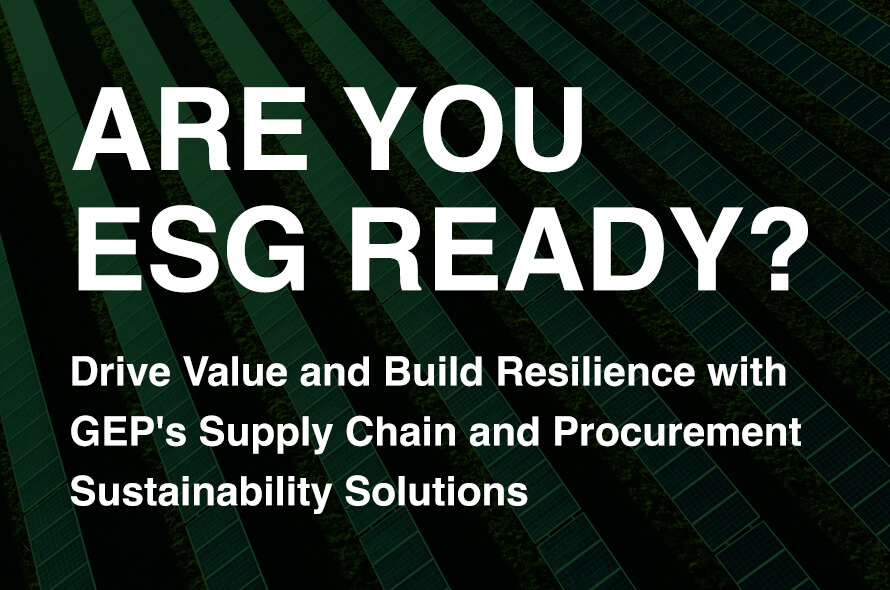Sustainability has emerged as the key corporate goal across industries, setting a challenge for companies to compete on sustainability at a global scale. Sustainability in short is all about achieving development goals to meet the current needs, but without compromising on the needs of future generations.
So, what is a sustainable value chain? A sustainable value chain is a mix of product development and the supply chain process – from the sourcing of raw materials to delivering the final product to the completion of the product lifecycle and back to the source, with the aim of minimal environmental or social impact. Therefore, sustainable value chain management ensures achieving sustainability goals through the business while maximizing the benefits for concerned stakeholders.
Ready for Growth? GEP Has the Answers
Transform your business with our AI-powered procurement and supply chain software and services
Sustainability in supply chain management is the ability to maintain the standardized processes without affecting the environment. Supply chain sustainability aims to reduce the impact of factors affecting the environment like pollutants, deforestation, ozone depletion and global warming. To set the stage for a better understanding of supply chain sustainability, let us try to answer a few questions.
CONTENT
What is Supply Chain Sustainability?
Supply chain management focuses on speed, cost, reliability, optimization, and continuous improvement of the supply chain. Global supply chain sustainability efforts focus on goals that are environment friendly, improve resource optimization and retain or increase ROI at the same time. Sustainable chain management is put into practice right from the procurement of goods and services to delivering the right products at the right time.
Sustainable supply chain is a strategic business decision that includes sustainable sourcing, production, packaging, and optimized, responsible delivery of produced goods. SCM sustainability efforts under an enterprise’s corporate social responsibility activities also drive green operations and result in cost savings and an improved supply chain over the long term.
How to Build a Sustainable Supply Chain?
To build a sustainable supply chain, an enterprise needs to identify the issues in its supply chain management. The ideal scenario is to break down the supply chain pipeline into various identifiable segments, after which an enterprise can focus on adopting a circular supply chain where the raw materials are recycled back into the production process. The reduction in waste by recycling and reuse of materials creates a balance — where input equals output.
A crucial step in sustainable supply chain management is to bring behavioral changes throughout the supply chain, where the management must clarify the objectives to employees and provide the necessary help. Behavioral change is often possible through training and capacity building programs. Examples include creating awareness on waste management, energy efficiency, labor rights, women’s health and women empowerment.
Managing sustainable procurement is another important cog in building a sustainable supply chain. To adopt the sustainable procurement model, it helps to understand day-to-day involvement with suppliers. This involves setting up a supplier code of conduct, conducting supplier audits at regular intervals for proper supplier evaluation. Enterprises need to be aware of sustainable procurement tools like self-assessment questionnaires (SAQs), category risk evaluation, corrective action plans as well as sustainability scorecards.
Can Sustainable Supply Chains Be a Valuation Multiplier for Private Equity?
This GEP bulletin details why ESG is no longer just a checkbox but a core valuation driver
Role of Supply Chain Collaboration in Sustainability
Supply chain collaboration is an established practice in the industry to reduce operating costs, reduce leaked spend and increase margins, improve order management and productivity, as well as capture demand changes and reduce inventory liabilities among others – with an aim to create a sustainable supply chain in the long run.
The best supply chain collaboration tools leverage transformative technologies to centralize procurement for all trading partners associated with an organization. Real-time visibility ensures that just the right amount of inventory to fulfil commitments.
How to Improve Supply Chain Sustainability?
The practical, sustainable supply chain starts with mapping the entire sustainable chain. To improve sustainability in supply chains, managers must assess risks and opportunities. Prioritizing work is essential in achieving a sustainable supply chain. Sustainability in the supply chain improves by bringing in sustainable targets in the procurement process. Setting smart goals is key to establishing sustainability in the supply chain.
Maintaining transparency and clarifying sustainable objectives with clients and suppliers is essential. Enterprises can address sustainability challenges, waste management, and labor practices by working together with suppliers. Another critical element is multi-tier collaboration with suppliers to gain a comprehensive view of the entire supply chain. This way, it’s easier to group suppliers with similar objectives, thereby optimizing the supply chain.
Best Practices for Sustainable Supply Chain Management
These are the 10 easy to implement and easy to follow best practices for a sustainable supply chain.
- Supplier Code of Conduct
- Green Packaging
- Sustainable Transportation
- Ethical Sourcing
- Waste Reduction
- Life Cycle Assessment
- Product Design
- Stakeholder Engagement
- Reporting and Transparency
What are the Key Elements of Supply Chain Sustainability?
The three elements of a sustainable supply chain are as follows:
- Environmental Responsibility: It involves protecting the environment from potential harm caused due to supply chain activities like production, storage, packaging, transportation and other minute operations.
- Financial Responsibility: It addresses the financial needs of the firm. Financial markets include shareholders, employers/employees, customers, clients, business partners, domestic institutions and financial institutions.
- Social Responsibility: It involves principles, ethics, morals and philanthropic expectations of the society from a business. This means every person in a sustainable supply chain is treated fairly, equally and in line with human rights requirements.
Why is Supply Chain Sustainability Important?
The importance of supply chain sustainability is going beyond the green revolution. Taking measures in favor of nature and the environment is necessary, but companies should also focus on overall sustainability. Sustainability in the supply chain is key to improving productivity and optimizing costs.
Other benefits of supply chain sustainability include:
- Helps reduce environmental impact
- Brings continuous improvement in the supply chain
- Improves company partnerships
- Creates win-win business opportunities
- Promotes a conducive work culture
- Helps in implementing better CSR activities, thereby increasing a company’s goodwill
- Helps develop better supply chain risk mitigation techniques
What is the Long-Term Prospect of Supply Chain Sustainability?
Supply chain sustainability will continue to grow due to the advent of circular economy and circular supply chain strategy. An increasing number of logistics companies will focus on saving non-renewable energy and adopt sustainable practices. Supply chain professionals working closely with first-tier suppliers will adhere to sustainable practices and vouch for a circular supply chain strategy.
Conclusion
Supply chain sustainability will empower and optimize the way supply chain strategies are planned. Supply chain sustainability efforts will continue to grow, with more companies moving toward adopting a circular supply chain strategy.
Explore how GEP’s supply chain software and supply chain services are helping leading enterprises make their supply chains sustainable.












